

Zamioculcas is a houseplant that survives irregular care.
Zamioculcas key facts
Name – Zamioculcas zamiifolia
Family – Araceae
Type – indoor plant
Foliage – evergreen
Height – 1 ⅓ to 3 ft (0.5-1 m) indoors
Exposure: well-lit – Soil: soil mix – Care: easy
Repotting, watering and proper exposure are easy care tasks. Each will make your Zamioculcas even more beautiful!
Upon purchasing, if the pot is too small, repot your zamioculcas. This helps the plant grow more adequately.
Usually, plants are sold just before repotting is needed, so don’t delay. After that, every 2 or 3 years, repot your zamioculcas plant.
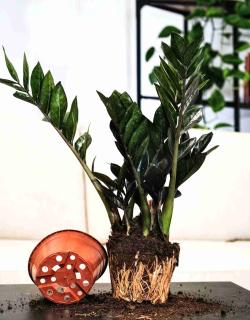
The best place to set your zamioculcas up is near a window. It should let a decent amount of light through, but not direct sunlight.
Zamioculcas have been noted to survive with very little light.
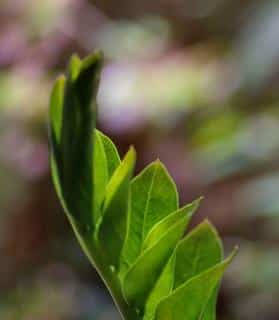 Indeed, Zamioculcas is vulnerable to excess sun, and tolerates part shade when outdoors.
Indeed, Zamioculcas is vulnerable to excess sun, and tolerates part shade when outdoors.When well-exposed and watered, a new Zamioculcas shoot can grow up to an inch in three days (1 cm/day)!
Regular but moderate watering will help your zamioculcas thrive.
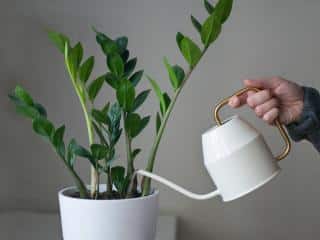
How often should you water zamioculcas? It depends on the season:
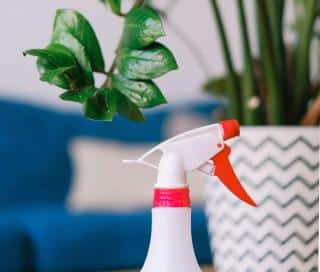
Add leaf plant liquid fertilizer every 8 to 15 days during the growing phase.
Reduce watering and wait for soil to be dry before watering again. Your Zamioculcas will benefit from having a dry, dormant season every year during winter.
Growth slows, and in some cases leaves fall off entirely, much like deciduous trees outdoors. Don’t worry: new sprouts appear in spring.
It’s easy to multiply zamioculcas, but it takes months. An effective technique is that of leaf cuttings.
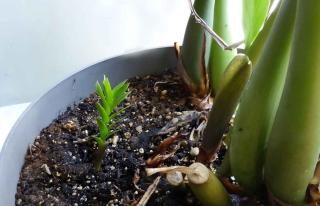 Cut a healthy stem off from the Z. zamiifolia plant.
Cut a healthy stem off from the Z. zamiifolia plant.After about 2 to 4 months, leaves wilt away. From underground, new shoots appear. Transplant to individual pots at this stage.
Instead of preparing cuttings, another option is to simply split the root bunch. This is called dividing the plant.
If your Zamioculcas stems and leaves turn yellow, it is most certainly due to excess watering. Overwatering also results in leaves losing their firmness and become soft.
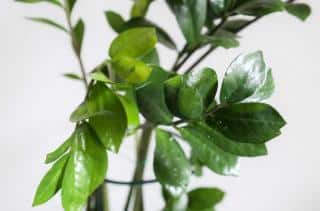
This might happen after forgetting to water for over a month. Simply resume watering, a bit more regularly this time. New growth will sprout.
One last point regarding parasites: Zamioculcas is vulnerable to scale insects.
Zamioculcas is a recent commercial plant. In 30+ years, not many prized mutations have appeared.
An exciting development appeared in 2017: a black Zamioculcas. It is sold under the name Raven ZZ plant.
Zamioculcas got its “ZZ plant” nickname from its botanical name: “Zamioculcas zamiifolia”. It originated in southern Africa in the Zanzibar region. This explains why one of its common names is also “Zanzibar gem“.
One of the previous names was Caladium zamiifolium, possibly because of the resemblance of its roots to those of the Caladium family. However, that name has since been replaced.
Zamioculcas contains microscopic calcium oxalate crystals. These crystals are irritating compounds in sap, leaves and roots. Calcium oxalate causes rashes. Although this may be uncomfortable, there’s no need to panic if your child or pet have ingested small amounts.
Zamioculcas isn’t toxic, poisonous or life-endangering in small quantities. The irritation may cause light swelling and pain.
Zamioculcas is considered a “succulent”. In the wild, stems store water during floods. It can survive for months without watering. Zamioculcas is an appealing houseplant for forgetful people!
Thanks for sharing so much about the watering. Mine is a victim of my moods, sometimes I water it every day, sometimes it goes for a month without anything. I know it survives but I was wondering if adding that water gel stuff would help or not.